With the Flow – New York State Watershed Report for the Week of Dec 6 - 12, 2021 – Flows are very calm this week, with some above normal in the Delaware River watershed
Find information on the river flows in your watershed each week. WTNY records one weekly measurement, taken as a snapshot of the volume of water flowing through the state’s major rivers and their tributaries, as recorded at USGS streamflow monitoring stations. The report captures your watershed flows from headwaters to outlet as of the date indicated. Systems reporting much above normal or high flows (in the top 10% of flow volume for that system) are shown in boldface; flows in action stage or flood stage appear in red. Flows can change rapidly, always check your local station at the USGS WaterWatch Current Streamflow for real time values.
Impaired Water Bodies in each watershed are listed here – these are lakes, creeks, rivers and reservoirs that have been recommended for a Clean Water Plan, a collaboration of municipal, industrial and environmental groups working together in an overlay zoning district for the specific purpose of addressing water quality. These are surface water bodies where water quality tests indicate stress: excess nutrients, contaminants, or low oxygen; these water bodies are listed on New York State 2018 Final Section 303 (d) list, along with the contaminant of concern and suspected source of contamination. The NYS DEC recommends the water body for a Total Maximum Daily Load (TMDL) watershed protection plan, and local watershed organizations, industry and municipalities are encouraged to undertake projects.
Hazardous materials spills reported to NYS Spills Database are included in the relevant in watershed section each week. The spill records are received and stored by county, we report these spills in their relevant watersheds on the basis of the majority of the county flow.
WaterToday New York gathers data from EPA, USGS, NWS, NOAA sources; accuracy is dependent on these sources.
Central NY Watersheds emptying into Atlantic Ocean at Long Island Sound
Upper Hudson River Watershed –
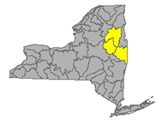
The Upper Hudson River Watershed drains the south side of the Adirondack Mountains, originating on Mt. Marcy and flowing south; the watershed management area extends to the Albany-Rensselaer County line. From the confluence of the Mohawk River, the Lower Hudson River gathers volume and carries on south to the Atlantic via Long Island Sound tidal estuary.
Including Sacandaga River, Schroon River, Indian River, Fish Creek, Hoosic River, Batten Kill, Great Sacandaga Lake, Indian Lake, Schroon Lake, Saratoga Lake
Flows: parts of Essex, Hamilton, Saratoga, Washington, Rensselaer and Warren Counties (updated 11-28-21)
- The Upper Hudson River drains an area of 8288 sq miles from headwaters to Albany; flow at Newcomb in Essex County is normal, 80% above mean at 280 cfs and 2.39 ft deep; at North Creek in Warren County is 102% above mean at 1480 cfs and 4 ft deep; at Fort Edward is 106% above mean at 6710 cfs and 22.11 ft deep; at Thomson in Washington County is 97% above mean at 7060 cfs and 21.1 ft deep; above Lock 1 near Waterford is flowing above normal, 142% above normal at 12600 cfs. (flow information updated 2021-12-05)
- Indian River drains an area of 132 sq miles in Hamilton County. The flow near Indian Lake is rated normal at 161 % above mean flow at 429 cfs and 2.73 ft deep. (updated 2021-12-05)
- Sacandaga River drains an area of 1055 sq miles in Hamilton and Saratoga Counties. The flow is normal near Hope, 75% above mean at 853 cfs and 2.81 ft deep; at Stewart’s Bridge near Hadley is flowing above normal, 161% above mean at 4050 cfs and 5.42 ft deep (updated 2021-12-05)
- Glowegee Creek drains an area of 26 sq miles in Saratoga County. The flow near West Milton is normal, 95% above mean at 44.6 cfs and 3.46 ft deep. (updated 12-05)
- Batten Kill drains an area of 396 sq miles of Washington County. The flow below Mill at Battenville is above normal, 185% above mean at 1350 cfs and 6 ft deep. (updated 12-05)
- Hoosic River drains an area of 510 sq miles in Rensselaer County. The flow near Eagle Bridge is flowing above normal, 138% above mean at 1450 cfs and 4.38 ft deep. (updated 12-05)
- Schroon River drains an area of 527 sq miles in Warren County; the flow at Riverbank is not rated, registers 3.34 ft deep (updated 12-05)
- Glens Falls Feeder (canal) in Washington County is flowing 2.8% above mean at 2.16 cfs and 2.16 ft deep (updated 12-05)
Upper Hudson River – Black River Regulating District operates the largest reservoir in the state, the Conklingville Dam, 37.7 billion cubic ft of storage from which flows 40% of the Hudson River volume.
Impaired Water Bodies (3 recommended for total maximum daily load TDML plan)
- Dwaas Kill and tributaries
- Ballston Lake
- Tributaries to Lake Lonely
Spill Report
Saratoga County: none reported
Washington County: None reported
Warren County:
-Equipment failure in Pottersville caused 100 gallons of #2 fuel oil to be spilled in the soil and surface water 11/29/21, unresolved
Hamilton County: None reported
Lower Hudson River Watershed
Spill Report
Westchester County:
-Equipment failure in Tuckahoe caused unknown amounts of #2 fuel oil to be spilled in the soil 11/29/21, unresolved
-Equipment failure in Mount Kisco caused unknown amounts of #2 fuel oil to be spilled on an unknown resource 11/29/21, unresolved
-Equipment failure in Waccabuc caused unknown amounts of #2 fuel oil to be spilled on an unknown resource 11/29/21, unresolved
-Equipment failure in Hartsdale caused 2 gallons of #2 fuel oil to be spilled on an unknown resource 11/29/21, unresolved
-Equipment failure in Mount Kisco caused unknown amounts of #2 fuel oil to be spilled in the soil 11/29/21, unresolved
-Human error in Mount Vernon caused 0.5 gallons of #2 fuel oil to be spilled on an unknown resource 11/29/21, resolved 12/01/21
-Equipment failure in Briarcliff manor caused 1 gallon of #2 fuel oil to be spilled in the soil 11/29/21, resolved 11/30/21
Orange County:
-Equipment failure in Westtown caused unknown amounts of #2 fuel oil to be spilled in the soil 11/29/21, unresolved
Putnam County:
-None reported
Columbia County:
-None reported
Rensselaer County:
-None reported
Delaware River Watershed
Spill Report:
Sullivan County:
-None reported
Delaware County:
-Traffic accident in Hancock caused unknown amounts of diesel to be spilled in the soil 11/29/21, unresolved
Ulster County:
-Unknown cause in New Paltz caused unknown amounts of unknown petroleum to be spilled on an unknown resource 11/29/21, unresolved
-Equipment failure in New Paltz caused unknown amounts of #2 fuel oil to be spilled on the soil 11/29/21, resolved 12/02/21
Housatonic River Watershed
Spill Report:
Dutchess County:
-None reported
Ramapo River Watershed
Rockland County:
-None reported
Atlantic Ocean/Long Island Sound Watershed
Spill Report:
Kings (Brooklyn):
-Unknown cause in Brooklyn caused unknown amounts of #2 fuel oil to be spilled on an unknown resource 11/29/21, unresolved
Queens County:
-None reported
Nassau County:
-Equipment failure in Seaford caused 0.5 gallons of #2 fuel oil to be spilled on an impervious surface 11/29/21, unresolved
-Equipment failure in Wantagh caused 50 gallons of #2 fuel oil to be spilled in the soil 11/29/21, unresolved
Suffolk County:
-Equipment failure in Smithtown caused unknown amounts of diesel to be spilled on an unknown resource 11/29/21, unresolved
-Equipment failure in Cutchogue caused 200 gallons of #2 fuel oil to be spilled in the soil 11/29/21, unresolved
-Equipment failure in Farmingville caused 100 gallons of #2 fuel oil to be spilled on the soil 11/29/21, unresolved
-Unknown cause in Babylon caused unknown amounts of #2 fuel oil to be spilled in the soil 11/29/21, unresolved
Richmond County:
-None reported
Bronx County:
-None reported
Mohawk River Watershed
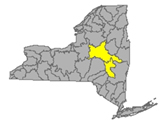
The Mohawk River originates in the western Adirondacks and the Tug Hill Plateau and flows 140 miles to the east where it joins the Hudson River. Sections of the Mohawk River also serve as the New York State Barge (Erie) Canal.
Including Schoharie Creek, West Canada Creek, East Canada Creek; Hinkley Reservoir, Delta Reservoir, Peck Lake, Schoharie Reservoir; joins the Hudson River below Albany.
Flows: taking the drainage from parts of Schenectady, Oneida, Herkimer, Montgomery and Albany Counties
- Mohawk River drains an area of 3450 sq miles in Oneida, Herkimer, Montgomery, Schenectady and Albany Counties. The flow at Delta Dam near Rome is flowing normal, 96% above mean at 407 cfs and 2.92 ft deep; near Utica in Herkimer County is flowing normal, 82% above mean flow at 1430 cfs and 7.39 ft deep; at Fonda is flowing 197% above mean at 5370 cfs and 13.21 ft deep; at Amsterdam in Montgomery County is flowing 92% above mean at 7150 cfs, and 11.9 ft deep; at Lock 8 near Schenectady in Schenectady County is 10.8 ft deep and 2.8°C with a specific conductance of 296 µS/cm; at Freeman’s Bridge in Schenectady County is flowing 145% above mean at 7260 cfs and 10.4 ft deep; at Cohoes in Albany County is flowing normal, 114% above mean at 8290 cfs and 11.57 feet deep above the confluence with the Hudson River. (updated 12-05)
- Oriskany Creek drains an area of 144 sq miles in Oneida County into the Mohawk River. The flow at Oriskany is 93% above mean at 251 cfs and 3.45 ft deep. (updated 12-05)
- West Canada Creek drains an area of 560 sq miles in Herkimer County into the Mohawk River. The flow at Kast Bridge in Herkimer County is above normal, 131% above mean at 1930 cfs and 3.85 ft deep. (updated 12-05)
- East Canada Creek drains an area of 289 sq miles of Herkimer County into the Mohawk system. The flow at East Creek in Herkimer is rated low, 42% above mean flow at 335 cfs and 2 ft deep (updated 12-05)
- Fulmer Creek drains an area of 21.7 sq miles of Herkimer County into the Mohawk system. The flow at Mohawk is normal, 81% above mean at 26.5 cfs and 2.77 ft deep. (updated 12-05)
- Sauquoit Creek drains an area of 59.8 sq miles of Oneida County into the Mohawk River. The flow at Whitesboro is normal, 91% above mean at 87.5 cfs and 2.34 ft deep. (updated 12-05)
- Steele Creek drains an area of 26.4 sq miles in Herkimer County into the Mohawk River. The flow at Ilion is normal, 102% above mean, 44.5 cfs and 2 feet deep. (updated 12-05)
- Otsquago Creek drains an area of 61 sq miles in Montgomery County into the Mohawk system. The flow at Fort Plain is normal 105% above mean at 79.2 cfs and 1.65 ft deep. (updated 12-05)
- Schoharie Creek drains an area of 886 sq miles of Schoharie County north to the Mohawk system; at near Lexington is 37.5% above mean at 129 cfs and 2.5 ft deep; at Prattsville is flowing normal, 52% above meat at 254 cfs and 3.61 ft deep; at North Blenheim is flowing normal, 105% above mean at 392 cfs and 2.64 ft deep; at Breakabeen is flowing normal, 93.5% above mean and 527 cfs; at Burtonsville in Schoharie County is flowing normal 102% above mean, at 1160 cfs and 1.88 ft deep. (updated 12-05)
- Schoharie Reservoir receives rainfall and snow melt run-off from an area of 315 sq miles in Schoharie County.
- Platter Kill drains an area of 10 sq miles in Schoharie County into the Schoharie Creek. The flow at Gilboa is above normal at 134% above mean flow, 17.9 cfs and 2 ft deep. (updated 12-05)
Impaired Water Bodies (9 recommended for TDML plan)
These are lakes, reservoirs, rivers, or parts of rivers where water quality tests indicate the system is impaired; the water body is placed on New York State 2018 Final Section 303 (d) list, along with the contaminant of concern and suspected source of contamination. The NYS DEC recommends the water body for a Total Maximum Daily Load (TMDL) watershed protection plan.
- Mohawk River main stem, portion 12 and 13 (Herkimer, Oneida)
- Utica Harbor (Oneida)
- Ann Lee (Shakers) Pond, Stump Pond
- Collins Lake
- Mariaville Lake
- Schoharie Reservoir
- Cobleskill Creek and lower tributaries
- Steel Creek
- Ballou, Nail Creeks
Spill Report – no new spill records since our last update 11-24
Montgomery County: None reported
Schoharie County: None reported
Herkimer County: None reported
Greene County: none reported
Schenectady County: none reported
Fulton County: None reported
Lower Hudson River Watershed –
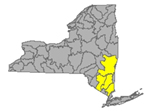
The Lower Hudson Watershed begins where the Mohawk River joins the Hudson system at the Troy Dam and extends down to Manhattan. The lower end of the Hudson system, 153 miles, is technically a tidal estuary, not a river.
Rondout/Wallkill Rivers, Stockport/Kinderhook Creeks, Catskill Creek, Esopus Creek, Croton River; Ashokan Reservoir, Rondout Reservoir, New Croton Reservoir, Alcove Reservoir, Cross River Reservoir, Muscoot/Upper New Croton Reservoir
Flows: catching parts of Albany, Rensselaer, Dutchess, Columbia, Ulster Counties
- Hudson River drains a total area more than 12,600 sq miles in New York State. At Green Island in Albany County, the Hudson is flowing above normal, 133% above mean to 22600 cfs; at Port of Albany, flow is 1.69 ft deep, 3.2°C and 248 µS/cm;
the tidal estuary near Poughkeepsie station in Dutchess County is malfunctioning; at Piermont the flow is not rated, 1.34 ft deep; at South Dock at West Point in Orange County is 5.1°C with specific conductance of 309 µS/cm. (updated 12-05)
- Esopus Creek drains an area of 419 sq miles of Ulster County; below Lost Clove Rd at Big Indian in Ulster the flow is normal, 67% over mean at 49.3 cfs and 3.36 ft deep; at Allaben is 61% above mean at 104 cfs and 3.5s ft; near Lomontville is flowing high, 663% above normal at 959 cfs and 5 ft deep; at Mount Marion is above normal, 181% above mean at 1070 cfs and 15.5 ft deep. (updated 12-05)
- Normans Kill drains 168 sq miles of Albany County. The flow at Albany is 142% above mean at 166 cfs and 3.49 ft deep; (updated 12-05)
- Valatie Kill drains an area of 9.8 sq miles of Rensselaer County before joining the Hudson; the flow near Nassau is normal 142% above mean at 21.1 cfs and 1.84 feet deep. (updated 12-05)
- Kinderhook Creek drains an area of 329 sq miles in Columbia County before joining the Hudson River. The flow at Rossman is above normal, 178% above mean at 830 cfs and 3.58 ft deep. (updated 12-05)
- Wappinger Creek drains an area of 181 sq miles of Dutchess County; the flow at Wappinger Falls is above normal, 80% above mean at 210 cfs and 3.78 ft deep. (updated 12-05)
- Rondout Creek drains an area of 383 sq miles in Ulster County; at Lowe’s Corners is much above normal, 281% above mean, 334 cfs and 2.82 ft deep; the flow at Rosendale is normal, 64% above mean at 411 cfs and 9.69 ft deep;
- Croton River drains an area of 378 sq miles of Westchester County into the Croton Reservoir for the New York City water supply. The flow at New Croton Dam near Croton-on-Hudson is normal at 42.75% above mean at 141 cfs and 2.02 ft deep. (updated 12-05)
- Muscoot River drains an area of 19.7 sq miles in Westchester County into the New Croton Reservoir. The flow below dam at Amawalk is 44% above mean at 13.5 cfs and 8.45 ft deep. (updated 12-05)
Impaired Water Bodies (25 listed for Total Maximum Daily Load plan, as of June 2020)
- Sawmill River, Lake Shenorock, Lake Lincolndale, Lake Ketonah, Truesdale Lake, Teatown Lake, Lake Meahagh, Wallace Pond, Lake Mohegan in Westchester County
- Hillside Lake, Wappingers Lake, Falkill Creek in Dutchess County
- Krumkill Creek, Patroon Creek, Minor tributaries west of Hudson River in Albany County
- Sparkill Creek in Rockland County
- Lost Lake, Putnam Lake in Putnam County
- Monhagen Brook in Orange County
- Ashokan Reservoir and Esopus Creek in Ulster County
- Robinson Pond in Columbia County
- Sleepy Hollow Lake in Greene County
- Duane Lake in Schenectady County
- Nassau Lake and Snyders Lake in Rensselaer County
Spill Report
Westchester County:
-Equipment failure in Tuckahoe caused unknown amounts of #2 fuel oil to be spilled in the soil 11/29/21, unresolved
-Equipment failure in Mount Kisco caused unknown amounts of #2 fuel oil to be spilled on an unknown resource 11/29/21, unresolved
-Equipment failure in Waccabuc caused unknown amounts of #2 fuel oil to be spilled on an unknown resource 11/29/21, unresolved
-Equipment failure in Hartsdale caused 2 gallons of #2 fuel oil to be spilled on an unknown resource 11/29/21, unresolved
-Equipment failure in Mount Kisco caused unknown amounts of #2 fuel oil to be spilled in the soil 11/29/21, unresolved
-Human error in Mount Vernon caused 0.5 gallons of #2 fuel oil to be spilled on an unknown resource 11/29/21, resolved 12/01/21
-Equipment failure in Briarcliff manor caused 1 gallon of #2 fuel oil to be spilled in the soil 11/29/21, resolved 11/30/21
Orange County:
-Equipment failure in Westtown caused unknown amounts of #2 fuel oil to be spilled in the soil 11/29/21, unresolved
Putnam County: None reported
Columbia County: None reported
Rensselaer County: None reported
Delaware River Watershed
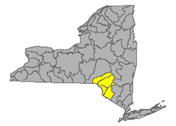
Delaware River headwaters flow down from the Catskill Mountains into Delaware Bay/Atlantic Ocean. The watershed area includes East Branch Delaware River, West Branch Delaware River, Neversink River, Mongaup River, Pepacton Reservoir, Cannonsville Reservoir and Neversink Reservoir.
Flows: streaming from parts of Delaware, Ulster, Sullivan Counties
- East Branch Delaware River drains an area of 458 sq miles in Delaware County. The flow at Roxbury is normal, 70% above mean at 18.6 cfs; at Margaretville is normal, 73% above mean at 265 cfs and 3.13 ft deep; 3.0°C and 76 µS/cm; at Downsville in Delaware County reporting flow above normal, 221% above mean, 415 cfs and 3.57 ft deep, 8.8°C; at Harvard flowing above normal, 146% above mean, 617 cfs and 3.75 ft deep, 5.4°C; at Fishs Eddy is above normal, 113% above mean at 1410 cfs and 5.64 ft deep, 4°C; (updated 12-05)
- West Branch Delaware River drains an area of 595 sq miles of Delaware County. The flow upstream from Delhi is normal, 80% above mean at 227 cfs and 2.85 ft deep; at Walton in Delaware County is normal, 95% above mean at 723 cfs and 4.9 ft deep, 2.4°C and 94 µS/cm; at Stilesville in Delaware County is much above normal at 377% above mean at 1480 cfs and 8.85 ft deep and 8.0°C; at Hale Eddy in Delaware County is flowing much above normal, 276% above mean flow at 1860 cfs and 4.68 ft deep, 9.1°C; (updated 12-05)
- Tremper Kill drains an area of 33 sq miles of Delaware County; the flow at Andes in is 94% above normal at 70 cfs and 3 ft deep, 2.0°C and 76 µS/cm (updated 12-05)
- Neversink River drains an area of 93 sq miles in Ulster and Sullivan Counties. West Branch Neversink River at Winnisook Lake near Frost Valley headwaters, the flow is 18% above mean at .41 cfs and 1.24 ft deep, 0.8°C and 13 µS/cm; at Bridgeville is normal, 47.7% above mean at 128 cfs and 5.33 ft deep, 4°C and 58 µS/cm; at Neversink is flowing much above normal, 477% above mean at 196 cfs and 3.7 ft deep, 7.3°C and 24 µS/cm; near Claryville in Sullivan County is normal, 89% above mean at 193 cfs and 6.43 ft deep, 2.4°C and 26 µS/cm. (updated 12-05)
- Delaware River drains an area of 1820 sq miles of Delaware County and across the state line to empty into . The flow at Calicoon is normal, 113.5% above meat at 3790 cfs and 4.38 ft deep, near Barryville is flowing normal, 115% above mean at 3970 cfs and 4.77 ft deep, 3.8°C; at Port Jervis the flow is normal, 94% above mean at 5150 cfs and 3.98 ft deep; 3.9°C and 84 µS/cm. (updated 12-05)-
- Little Delaware River drains an area of 49.8 sq miles in Delaware County into the Delaware River. The flow near Delhi is normal, 89% above mean at 97.2 cfs and 2.94 ft deep. (updated 12-05)
- Trout Creek drains an area of 20.2 sq miles in Delaware County direct to the Delaware River. The flow at Trout Creek is above normal, 129% above mean at 48.8 cfs and 3.56 ft deep. (updated 12-05)
- Beaver Kill drains an area of 241 sq miles in Delaware County. The flow at Cooks Falls is normal, 72% above mean at 473 cfs and 2.65 ft deep and 2°C. (updated 12-05)
- Callicoon Creek drains an area of 110 sq miles in Sullivan County. The flow at Callicoon is much above normal, 228% above mean at 436 cfs and 2 ft deep. (updated 12-05)
- Mongaup River drains an area of 200 sq miles in Sullivan County. The flow near Mongaup Valley is normal, 42% above mean at 154 cfs and 1.57 ft deep, 5.7°C and 92 µS/cm. (updated 12-05)
Impaired Water Bodies (6 recommended for Total Maximum Daily Load plan development, as of June 2020)
Sullivan County
- Davies Lake, Pleasure Lake, Evens Lake, Swan Lake, Bodine/Montgomery Lake
Broome County
- Fly Pond/Deere Lake
Spill Report:
Sullivan County: None reported
Delaware County:
-Traffic accident in Hancock caused unknown amounts of diesel to be spilled in the soil 11/29/21, unresolved
Ulster County:
-Unknown cause in New Paltz caused unknown amounts of unknown petroleum to be spilled on an unknown resource 11/29/21, unresolved
-Equipment failure in New Paltz caused unknown amounts of #2 fuel oil to be spilled on the soil 11/29/21, resolved 12/02/21
Housatonic River Watershed
A small portion of the headwaters of the Housatonic lie in eastern New York State. These waters drain the Taconic and Berkshire Mountains before joining the Housatonic and eventually emptying into Long Island Sound. Includes Tenmile River, Green River, Indian Lake, Swift/Crane Ponds
Flows: parts of Dutchess County
Housatonic and Green Rivers are flowing at normal range, as noted in monitoring stations at Great Barrington, Vermont. (updated 12-05)
Impaired Water Bodies
- none
Spill Report:
Dutchess County: none reported
Ramapo River Watershed
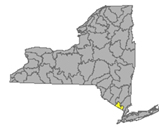
The northern headwaters of the Passaic basin lie within a small portion of southeastern New York State, including the Ramapo and Hackensack Rivers drainage areas. It is the smallest watershed in New York State. Including Ramapo River, Hackensack River, Greenwood Lake, DeForest Lake.
Flows: concerned with parts of Rockland and Orange Counties
- Mahwah River drains an area of 12 sq miles in Rockland. The flow near Suffern is low, 34% above mean at 10.8 cfs and 1.79 feet deep (updated 12-05)
- Ramapo River drains an area of 93 sq miles in Rockland County. The flow at Mahwah is normal, 41% above meant at 113 cfs and 3.24 ft deep; at Suffern is normal this week, 37% above mean at 89.6 cfs and 2.75 ft deep. (updated 12-05)
- Hackensack River drains an area of 30.7 sq miles in Rockland County. The flow at West Nyack is normal, 44.5% above mean at 14.4 cfs and 2.46 ft deep. (updated 12-05)
Impaired Water Bodies (2 recommended for TDML plan)
Rockland County
- Rockland Lake
- Congers Lake/Swartout Lake
Spills Report:
Rockland County: no new records since last update 11-24
Atlantic Ocean/Long Island Sound Watershed
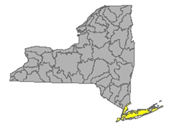
The Atlantic Ocean/Long Island Sound Watershed drains most of the New York City Metropolitan Area and all Long Island. The drainage area includes all marine waters in New York Harbor, Long Island Sound, Block Island Sound, and along the South Shore of Long Island, and the fresh waters that drain into them.
Includes 1415 square miles of marine estuary waters, the Bronx River, Mamaroneck River, Mianus River, Peconic River, Kensico Reservoir, Lake Ronkonkoma.
Flows: taking in run-off from parts of Bronx, Queens, Kings, Suffolk, Nassau, and New York Counties
- Valley Stream drains 3.77 sq miles in Nassau County. The flow at Valley Stream is much above normal, 323% above mean at 6.08 cfs and 1.13 ft deep. (updated 12-05)
- Sampawams Creek drains an area of 23 sq miles in Suffolk County. The flow at Babylon is above normal, 134% above mean at 12.3 cfs and .71 ft deep. (updated 12-05)
- Bellmore Creek drains an area of Nassau County. The flow at Bellmore is above normal, 49% above mean and 4.94 cfs and .45 ft deep. (updated 12-05)
- Massapequa Creek drains an area of 38.6 sq miles in Nassau County. The flow at Massapequa is rated low, 45% above mean at 3.66 cfs and .7 ft deep. (updated 12-05)
- East Meadow Brook drains an area of 28.7 sq miles of Nassau County. The flow at Freeport is normal, 49% above mean at 4.94 cfs and .45 ft deep (updated 12-05)
- Mill Neck Creek drains an area of 8.58 sq miles of Nassau County. The flow at Mill Neck is normal, 95% above mean at 8.81 cfs and .25 feet deep. (updated 12-05)
- Swan River drains an area of 8 sq miles in Suffolk County. The flow at East Patchogue is above normal, 112% above at 13.2 cfs and .53 ft deep. (registers same numbers as 11-24, updated 12-05)
Impaired Water Bodies (49 recommended for TDML plans)
Richmond County:
- Arthur Kill (oxygen demand)
- Grasmere Lake/Brady’s Pond (phosphorous)
New York County:
- The Lake in Central Park (phosphorous)
- Harlem Meer (phosphorous)
Bronx County:
- Van Cortlandt Lake (phosphorous)
- Reservoir #1/ Lake Isle (phosphorous)
Westchester County:
- Bronx River, Upper and tributaries (oxygen demand, fecal coliform)
- Larchmont Harbour (fecal coliform)
- Hutchison River, upper and tributaries (oil and grease, oxygen demand, fecal coliform)
- Mamaroneck Harbour (fecal coliform)
- Mamaroneck River, lower, Upper, tributaries (oxygen demand, silt/sediment)
- Sheldrake River (phosphorous, silt/sediment)
- Silver Lake (phosphorous)
- Milton Harbor/Lower Blind Brook (fecal coliform)
- Port Chester Harbor/Lower Byram River (fecal coliform)
Nassau County
- Manhasset Bay and tidal tributaries (fecal coliform)
- Hempstead Harbour (fecal coliform)
- Beaver Lake (phosphorous)
- Massapequa Cove, Upper Creek and Tributaries (fecal coliform, phosphorous)
- Seaford, Seamans Creeks, tidal tributaries (fecal coliform)
- Tributaries to East Bay (freshwater silt/sediment and phosphorous)
- Canaan Pond (phosphorous)
- East Meadow Brook upper and tributaries (silt/sediment)
- Milburn/Parsonage Creek and tributaries (phosphorous)
- Hempstead Bay and tributaries /Broad Channel (phosphorous, nitrogen)
- Hewlett Bay (nitrogen)
- Browsere Bay (nitrogen)
- Hog Island Channel (nitrogen)
- East Rockaway Channel (nitrogen)
- Hempstead Lake (phosphorous)
- Grant Park Pond (phosphorous)
- Woodmere Channel (nitrogen)
- Bannister Creek/Bay (nitrogen)
- Prospect Park Lake (phosphorous)
Queens County
- Meadow Lake (phosphorous)
- Willow Lake (phosphorous)
- Kissena Lake (phosphorous)
- Little Neck Bay (fecal coliform)
Suffolk County
- Millers Pond (phosphorous, low oxygen)
- Long Island Sound (fecal coliform)
- Mattituck/Marratooka Pond (phosphorous, low oxygen)
- Agawam Lake (Phosphorous, low oxygen)
- Shinnecock Bay (Nitrogen)
- Quantuck Bay (Nitrogen, low oxygen)
- Moriches Bay, East and West, tidal tributaries (Nitrogen, low oxygen, fecal coliforms in west tributaries)
- Great South Bay, East, Middle and West (low oxygen, nitrogen)
- Canaan Lake (phosphorous, silt/sediment)
- Lake Ronkonkoma (fecal coliform, phosphorous)
- Champlin Creek, upper and tributaries (thermal changes)
Spill Report: records appearing after 11-24
Kings County
- Unknown cause in Brooklyn resulted in unknown amounts of #2 fuel oil to be spilled on an unknown resource 11/29/21, unresolved
Queens County: None reported
Nassau County:
-Equipment failure in Seaford caused 0.5 gallons of #2 fuel oil to be spilled on an impervious surface 11/29/21, unresolved
-Equipment failure in Wantagh caused 50 gallons of #2 fuel oil to be spilled in the soil 11/29/21, unresolved
Suffolk County:
-Equipment failure in Smithtown caused unknown amounts of diesel to be spilled on an unknown resource 11/29/21, unresolved
-Equipment failure in Cutchogue caused 200 gallons of #2 fuel oil to be spilled in the soil 11/29/21, unresolved
-Equipment failure in Farmingville caused 100 gallons of #2 fuel oil to be spilled on the soil 11/29/21, unresolved
-Unknown cause in Babylon caused unknown amounts of #2 fuel oil to be spilled in the soil 11/29/21, unresolved
Richmond County: None reported
Bronx County: None reported
Northeast Watersheds– emptying into Atlantic Ocean via St. Lawrence River
Lake Champlain Watershed

The Lake Champlain Watershed drains the area between the Adirondack Mountains in northeastern New York State and the Green Mountains in northwestern Vermont.
Includes the Ausable River, Saranac River, Great Chazy River, Boquet River, Mettawee River, Ticonderoga Creek/Lake George, Lake George,
Upper Saranac Lake, Lower Saranac Lake, Lake Placid, Lake Champlain
Flows: parts of Washington, Essex and Clinton Counties
- Mettawee River drains an area of 167 sq miles of Washington County into Lake Champlain. The flow near Middle Granville is above normal, 145% above mean at 492 cfs and 4.66 feet deep (updated 12-05)
- Boquet River drains an area of 207 sq miles of Essex County. The flow at Willsboro is normal, 71.5% above mean at 193 cfs and 2.79 ft deep. (updated 12-05)
- Ausable River drains an area of 198 sq miles of Clinton County. The flow near Au Sable Forks is normal, 78% above mean at 443 cfs and 1.91 cfs; East Branch Ausable River at Au Sable Forks is normal, 82% above mean at 190 cfs and 1.73 ft deep; (updated 12-05)
- Salmon River drains an area of 63 sq miles in Clinton County. The flow at South Plattsburgh is normal is 80% above mean, 44.1 cfs and 1.22 ft deep. (updated 12-05)
- Saranac River drains an area of 608 sq miles. The flow at Plattsburgh is normal, 104% above mean at 824 cfs at 3.87 ft deep. (updated 12-05)
- Great Chazy River drains an area of 243 sq miles in Clinton County. The flow at Perry Mills is normal, 80% above mean at 197 cfs and 2.34 ft deep. (updated 12-05)
- Little Chazy River drains an area of 50 sq miles in Clinton County. The flow near Chazy is normal, 61% above mean at 40.2 cfs and 2.26 feet deep. (updated 12-05)
Impaired Water Bodies (6 recommended for TDML plan)
Clinton County –
- Great Chazy River, lower main stem (silt/sediment from agriculture and erosion)
Warren County-
- Lake George and its tributaries, including east tributaries and lake village (silt/sediment from urban stormwater drainage and erosion)
- Huddle/Finkel Brook and tributaries (silt/sediment from urban stormwater drainage and erosion)
- Indian Brook and tributaries (silt/sediment from urban stormwater drainage and erosion)
- Hague Brook and tributaries (silt/sediment from urban stormwater drainage and erosion)
Washington County-
- Wood Creek/Champlain Canal and tributaries (phosphorous, low oxygen, fecal coliforms)
Spill Report:
Clinton County:
-Housekeeping in Plattsburgh caused 1 gallon of diesel to be spilled on an unknown resource 11/29/21, unresolved
Essex County: None reported
St. Lawrence River Watershed
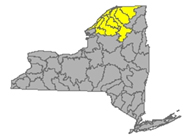
185 km of the St. Lawrence River catches the runoff from the northern and western Adirondack Mountains, drawing from portions of eight states, a combined area of 5600 square miles.
St. Lawrence Watershed collects the flow from eleven thousand miles of freshwater rivers and streams, including the Oswegatchie River, Raquette River, Saint Regis River, Grass River and Indian River; including Black Lake, Cranberry Lake, Raquette Lake, Tupper Lake and Long Lake. Densely forested woodlands, peatlands and areas of flat agricultural plains make up the natural surface water filtration system of this watershed area.
Flows: parts of St. Lawrence and Franklin Counties
- Raquette River drains 1125 sq miles of St. Lawrence County. The flow at Piercefield is normal, 98% above mean at 1350 cfs and 5.9 ft deep; at South Colton is normal, 129% above mean at 2240 cfs and 5.09 feet deep (flood stage is 10ft); at Raymondville is flowing normal at 86% above mean at 1780 cfs and 3 ft deep (updated 12-05)
- St. Regis River drains an area of 612 sq miles in St. Lawrence County. The flow Brasher Centre is normal, 83% above mean at 878 cfs and 6.57 ft deep. (updated 12-05)
- West Branch St. Regis River drains an area of 171 sq miles in St. Lawrence County. The situation near Parrishville is ice affected, 1.85 ft deep. (updated 12-05)
- Oswegatchie River drains an area of 986 sq miles in St. Lawrence County. The flow at Oswegatchie is normal 73% above mean, 434 cfs and 2.97 ft deep; the flow at Heuvelton is normal at 78% above mean, 1730 cfs and 2.67 feet deep. (updated 12-05)
- West Branch Oswegatchie River drains an area of 258 sq miles in St. Lawrence County. The flow near Harrisville is normal, 82% above mean at 542 cfs and 3.18 feet deep. (updated 12-05)
- Little Salmon River drains an area of 92 sq miles of Franklin County. The flow at Bombay is above normal, 116% above mean at 155 cfs and 3.27 ft deep. (updated 12-05)
Impaired Water Bodies (4 recommended for TDML plan)
St. Lawrence County
- Raquette River lower and minor tributaries (fecal coliform from onsite WTS)
- Black Lake Outlet, Black Lake (phosphorous, agriculture)
- Fish Creek and minor tributaries (phosphorous from OWTS, sanitary discharge)
- Little River and tributaries (priority organics from industrial site and landfill)
Spill Report
Franklin County: None reported
St. Lawrence County: none reported
Black River Watershed
The Black River headwaters begin in the Adirondack mountains, scoop southwest and then curve northwest, the flow proceeds north-northwest, hooks west and empties into Lake Ontario.
Major tributaries in the system include Moose River, Beaver River, Independence River and Deer River, Stillwater Reservoir, Fulton Chain of Lakes, Lake Lila and Big Moose Lake.
Flows: Filters and drains most of Jefferson and Lewis Counties along with parts of Herkimer, Hamilton and Oneida Counties.
- Black River drains an area of 1864 sq miles of Jefferson County. The flow at Boonville is normal, 105% above mean and 829 cfs and 5.28 ft deep; at Watertown flow is normal, 103% above mean at 5170 cfs and 5.14 feet deep. (updated 12-05)
- Beaver River drains 291 sq miles in Lewis County. The flow at Croghan is above normal, 135% above mean, 845 cfs and 3.33 ft deep. (updated 12-05)
- Independence River drains an area of 88.7 sq miles in Lewis County. The flow at Donnatsburgh is normal, 106% above mean at 229 cfs and 4.11 feet deep, .3°C (updated 12-05)
Impaired Water Bodies (1 recommended for TDML plan)
Lewis County
- Mill Creek south branch and tributaries (nutrients and fecal coliform from agriculture)
Spill Report: (updated 12-02)
Jefferson County: None reported
Lewis County: None reported
Northwest Watersheds – empty into Atlantic Ocean via Great Lakes and St. Lawrence River
Lake Ontario and Minor Tributaries
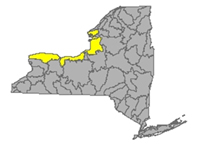
This watershed includes areas between the larger rivers draining to Lake Ontario. (including Genesee, Oswego and Black Rivers) . It is divided into western, central and eastern sections that stretch all along the Lake Ontario Shoreline.
*Includes Salmon River Reservoir, Sodus Bay, North Pond, Irondequoit Bay and Perch Lake, Salmon River, Oak Orchard Creek, Irondequoit Creek, Sandy Creek
Flows: considering parts of Monroe and Jefferson Counties
- Northrup Creek drains an area of 10.1 sq miles in Monroe County. The flow at North Greece in Monroe County is much above normal, 202% above mean at 24.7 cfs and 1.38 ft deep and 2.7°C (updated 12-05)
- Sandy Creek drains an area of 137 sq miles in Jefferson County. The flow at Adams is normal, 75% above mean at 310 cfs and 2.51 ft deep. (updated 12-05)
Impaired Water Bodies (6 recommended for TMDL plans)
Wayne County
- Lake Ontario Shoreline Central (fecal coliform from urban stormwater runoff)
Monroe County
- Rochester Embayment East and West, (fecal coliform from urban stormwater runoff)
- Buck Pond (phosphorous from urban stormwater/runoff)
- Long Pond (phosphorous from urban stormwater/runoff)
- Cranberry Pond (phosphorous from urban stormwater/runoff)
Orleans County
- Lake Ontario Shoreline, Western (fecal coliform from agriculture source, municipal and other sources)
Spill Report (updated 12-02)
Orleans County: None reported
Wayne County: none reported
Oswego: None reported
Niagara River/Lake Erie Watershed
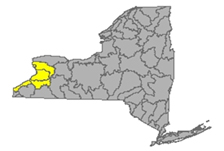
Draining an area encompassing more than 265,000 square miles in the north central United States and south-central Canada, including Tonawanda Creek, Cattaraugus Creek, Buffalo River; Attica Reservoir and Lime Lake.
Flows: parts of Niagara, Wyoming and Erie Counties
- Tonawanda Creek drains an area of 349 sq miles in Niagara, Genesee and Wyoming Counties. The flow at Attica is normal, 55% above mean at 75.8 cfs and 3.6 ft deep; at Batavia in Genesee County is normal, 53.5% above mean at 159 cfs and 2.22 feet deep; at Rapids is normal, 71% above mean at 414 cfs and 2.4 ft deep. (updated 12-05)
- Ellicott Creek drains an area of 82 sq miles in Niagara County. The flow at Williamsville is normal, 56% above mean, 103 cfs and 2.33 ft deep. (updated 12-05)
- Cazenovia Creek drains an area of 135 sq miles in Erie County. The flow at Ebenezer is normal, 56% above mean at 176 cfs and 2.84 ft deep. (updated 12-05)
- Buffalo Creek drains an area of 142 sq miles in Erie County. The flow at Gardenville is normal, 40% above mean at 106 cfs and 1.12 ft deep. (updated 12-05)
- Cayuga Creek drains an area of 96 sq miles in Erie County. The flow at Lancaster is normal, 46% above mean at 79.6 cfs and 3.78 ft deep. (updated 12-05)
- Cattaraugus Creek drains an area of 436 sq miles in Erie County. The flow at Gowanda is normal, 114% above mean at 1020 cfs and 2.84 ft deep, 3.2°C and 306 µ/cm. (updated 12-05)
Impaired Water Bodies (11 recommended for TDML plan)
Niagara County:
- Gill Creek and tributaries (unknown biological from urban runoff, contaminated sediment)
- Hyde Park Lake (phosphorous from urban stormwater runoff)
- Bergholtz Creek and tributaries (phosphorous and fecal coliform from urban runoff)
Erie County:
- Ransom Creek Upper Lower and tributaries (oxygen demand and fecal coliforms from onsite wastewater treatment system)
- Two Mile Creek and tributaries (oxygen demand and fecal coliform from combined sewer overflow (CSO’s), municipal source)
- Scajaquada Creek, upper, middle and lower (phosphorous, low oxygen, fecal coliform from combined sewer overflows (CSO), urban runoff)
- Delaware Park Pond (phosphorous from urban storm runoff)
- Lake Erie (fecal coliform from urban runoff)
- Rush Creek and tributaries (fecal coliform and phosphorous, from CSOs, urban runoff and municipal sources)
- Green Lake (phosphorous from urban runoff)
Chautauqua County:
- Lake Erie, main lake south, Dunkirk Harbor (fecal coliform from urban storm runoff)
Spill Report
Erie County:
-Equipment failure in West Seneca caused 20 gallons of hydraulic oil to be spilled on an unknown resource 11/29/21, unresolved
Niagara County: None reported
Genesee River Watershed
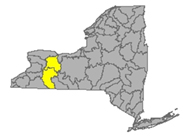
Genessee River originates in north central Pennsylvania. The Genesee runs right through New York state, more or less straight north from the south state line up to Lake Ontario at Rochester. The watershed includes the following tributary flows, lakes and reservoirs: Conesus Lake, Silver Lake, Mount Morris Reservoir, Hemlock Lake, Honeoye Lake; Cassadaga Creek, Honeoye Creek, Oatka Creek, Black Creek
Flows: parts of Monroe, Livingston and Allegany Counties
- Genessee River drains an area of 2474 sq miles in Monroe, Livingston, and Allegany Counties. The flow at Wellsville in Allegany County is normal, 88% above mean at 375 cfs and 5.09 ft deep; at Portageville in Wyoming County is normal 99% above mean at 1350 cfs and 10.13 ft deep; near Mount Morris in Livingston County is above normal, 87% above mean at 1900 cfs and 4.94 ft deep; at Avon flow is normal, 107% above mean flow, 2560 cfs and 21.6 ft deep; above normal at Ford St Bridge in Rochester, Monroe County, flow is normal, 107% above mean at 3410 cfs and 12.17 ft deep, 3.7°C and 421 µS/cm. (updated 12-05)
- Honeoye Creek drains an area of 196 sq miles of Monroe County. The flow at Honeoye Falls in Monroe County is above normal, 79% above mean at 106 cfs and 3.15 ft deep. (updated 12-05)
- Conesus Creek drains an area of 72 sq miles in Livingston County. The flow is below normal near Lakeville in Livingston County, 24% above mean at 15.7 cfs and .67 ft deep. (updated 12-05)
- Canaseraga Creek drains an area of 88.9 sq miles of Livingston County. The flow above Dansville is above normal, 110% above mean, at 113 cfs and 1.03 ft deep; at Shakers Crossing in Livingston County is flowing normal, 105% above mean at 316 cfs and 4.36 ft deep. (updated 12-05)
- Oatka Creek drains an area of 200 sq miles in Monroe County. The flow at Warsaw is 56% above mean at 31.5 cfs and 3.49 ft deep; at Garbutt normal, 63.5% above mean at 157 cfs and 2.81 ft deep. (updated 12-05)
- Black Creek drains an area of 130 sq miles in Monroe County. The flow at Churchville is normal, 82% above mean at 106 cfs and 2.12 ft deep, (same digits as 11-24, updated 12-05)
- Irondequoit Creek drains an area of 142 sq miles in Monroe County. The flow above Blossom Rd. near Rochester is normal, 65% above mean at 91.3 cfs and 3.22 ft deep, 1340 µS/cm. (updated 12-05)
Impaired Water Bodies (11 recommended for TDML plan)
Monroe County:
- Black Creek, Lower and minor tributaries (phosphorous from ag and municipal sources)
- Mill Creek Blue Pond Outlet and tributaries (phosphorous from agriculture)
Genesee County:
- Mill Pond (phosphorous from ag)
- Oatka Creek Middle and minor tributaries (phosphorous from agriculture, municipal sources)
- LeRoy Reservoir (phosphorous from agricultural sources)
- Black Creek, Upper and minor tributaries (phosphorous from agriculture and municipal sources)
Ontario County:
- Honeoye Lake (phosphorous and low oxygen demand from agriculture and onsite Waste treatment system)
Livingston County
- Conesus Lake (phosphorous and low oxygen from internal loading)
- Christie Creek and tributaries (phosphorous from agriculture source)
Allegany County:
- Andover Pond (phosphorous from agriculture source)
- Amity Lake/Saunders Pond (phosphorous from unknown source)
Spill Report:
Spill Report:
Livingston County: None reported
Allegany County: None reported
Monroe County: None reported
Genesee County:
-Equipment failure in Leroy caused unknown amounts of #2 fuel oil to be spilled in the soil and impervious surface 11/29/21, unresolved
Wyoming County: None reported
Oswego River and Finger Lakes Watershed
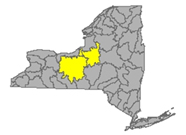
The Oswego River originates in the Adirondacks, with the combined flows of the Seneca River and many tributaries, drains a large area of north New York to Lake Ontario. The water bodies found in this drainage basin include the Finger Lakes: Otisco, Skaneateles, Owasco, Cayuga, Oneida, Seneca, Keuka, Canandaigua and Canadice Lakes; Oneida River, Clyde River, Cayuga Lake Tributaries and Seneca Lake Tributaries
Flows: drains parts of Oswego, Madison, Cayuga, Tompkins, Seneca, Onandaga, Yates and Ontario Counties
- Oswego River drains an area of 5100 sq miles of Oswego, Madison, Cayuga, Tompkins, Seneca, Onandaga, Yates and Ontario counties. The flow near Phoenix is not rated, 95% above mean at 10500 cfs and 3.16 ft deep; at Lock 7 in Oswego County is above normal, 141.5%, at 12600 cfs and 7.07 ft deep, 4.2°C and 578 µS/cm. (updated 12-05)
- Seneca River drains an area of 3130 sq miles of Onandaga County. The flow near Baldwinsville in Onandaga County is above normal, 147% above mean, at 6590 cfs and 3.41 ft deep, at Free Bridge Corners is 217% above normal at 3630 cfs and 9.1 ft deep; near Port Byron 120% above mean at 5720 cfs and 6.32 ft deep. (updated 12-05)
- Canandaigua Outlet drains 195 sq miles of Ontario County. The flow at Chapin in Ontario County is above normal, 227% above mean at 304 cfs and 4.27 ft deep. (updated 12-05)
- Flint Creek drains an area of 102 sq miles of Ontario County. The flow at Phelps in Ontario County is normal, 71% above mean flow at 61.7 cfs and 1.77 ft deep. (updated 12-05)
- Keuka Lake drains an area of 207 sq miles in Yates County. At the outlet near Dresden in Yates County, the flow is above normal, 148.5% above mean, 308 cfs and 3.58 ft deep. (updated 12-05)
- Oneida Creek drains an area of 113 sq miles in Oneida County. The flow at Oneida is normal, 83% above mean at 162 cfs and 2.65 ft deep. (updated 12-05)
- Onandaga Creek drains an area of 110 sq miles of Onandaga County. The flow at Spencer St in Syracuse is much above normal at 118% above mean at 224 cfs and 3.3 ft deep. (updated 12-05)
- Fall Creek drains an area of 126 sq miles of Tompkins County. The flow near Ithaca is normal, 95% above mean at 200 cfs and 1.53 ft deep. (updated 12-05)
Impaired Water Bodies (7 recommended for TDML plan)
Oswego County:
- Lake Neatahwanta (phosphorous from urban stormwater runoff)
- Pleasant Lake (phosphorous from unknown source
Madison County:
- Canastota Creek, lower and tributaries (fecal coliform, oxygen demand from municipal sources and combined sewer overflows)
Cayuga County:
- Owasco Upper Inlet and tributaries (nutrients from municipal and agricultural source)
- Duck Lake (phosphorous from unknown source)
Tompkins County:
- Cayuga Lake (phosphorous and silt/sediment from agriculture and urban stormwater runoff)
Seneca County:
- Reeder Creek and tributaries (phosphorous from unknown source)
Spill Report:
Seneca County: None reported
Cayuga County: None reported
Onondaga County:
-Deliberate cause in North Syracuse caused unknown amounts of motor oil to be spilled in the soil 11/29/21, unresolved
Schuyler County: None reported
Yates County: None reported
Ontario County: None reported
Madison: None reported
Tompkins: None reported
Oneida:
-Unknown cause in West Moreland caused 20 gallons of #2 fuel oil to be spilled in the soil 11/29/21, unresolved
-Unknown cause in Whitsboro caused unknown amounts of unknown material to be spilled in the soil and ground water 11/29/21, unresolved
Southwest Watersheds – Allegheny, emptying into Gulf of Mexico via Ohio River/Mississippi River; Chemung and Susquehanna emptying into Atlantic Ocean via Chesapeake Bay
Allegheny River Watershed (flowing west into Ohio River system)
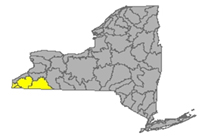
The Allegheny River originates in Pennsylvania, curving north to take a short loop through southwest New York and back down into PA. Tributaries to the Allegheny system include Chadakoin River, Conewango Creek, Cassadaga Creek, Olean Creek, Great Valley Creek, French Creek. Important water bodies include the Allegheny Reservoir and popular recreational destination, Chautauqua Lake.
Flows: taking in parts of Chautauqua and Cattaraugus County
- Chadakoin River drains an area of 194 sq miles of Chautauqua County. The flow at Falconer is above normal, 136% above mean at 679 cfs and 2.08 ft deep. (updated 12-05)
- Chautauqua Creek drains an area of 35 sq miles in Chautauqua County. The flow below Westfield is 90.5% above mean at 84.5 cfs and 1.25 ft deep (updated 12-05)
- Allegheny River drains an area of 1608 sq miles of Cattaraugus County. The flow at Olean is 73% above mean at 2350 cfs and 4.02 ft deep; the flow at Salamanca is normal, 103.5% above mean at 3300 cfs and 4.68 ft deep, 4.2°C. (updated 12-05)
Impaired Water Bodies (8 recommended for TDML)
Cattaraugus County:
- Allegheny River/Reservoir (phosphorous from unknown source)
- Linlyco/Club Pond (phosphorous from unknown source)
- Case Lake (phosphorous from unknown source)
- Beaver Lake/Alma Pond (phosphorous from internal loading)
Chautauqua County:
- Middle Cassadaga Lake (phosphorous from agriculture)
- Chadakoin River and tributaries (phosphorous from urban/industrial runoff)
- Hulburt/Clymer Pond (phosphorous from agriculture)
- Findlay Lake (low oxygen demand from agricultural source)
Spill Report: updated 12-02
Cattaraugus County: none reported
Chautauqua County: None reported
Chemung River Watershed
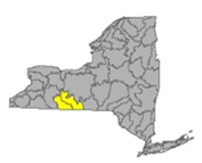
The Chemung River flows across the western portion of Southern Tier of New York State before joining the Susquehanna River and eventually emptying into the Chesapeake Bay.
Including Chemung River, Cohocton River, Tioga/Canisteo River; Lamoka Lake/Mill Pond, Waneta Lake, Almond Lake
Flows: washing over parts of Steuben and Chemung Counties
- Chemung River drains an area of 2506 sq miles in Steuben and Chemung Counties. The flow at Corning is normal, 86% above mean at 1940 cfs and 16.2 ft deep; at Elmira in Chemung County, flow is 98% above mean at 2180 cfs and 2.23 ft deep; at Chemung is 100% above mean at 2370 cfs and 4.66 ft deep. (updated 12-05)
- Canisteo River drains an area of 40 sq miles of Steuben County. The flow at Arkport is normal, 91% above mean at 31.2 cfs and 1.22 ft deep; below Canacadea Creek at Hornell in Steuben County is flowing above normal 133% above mean, 213 cfs and 1.75 ft deep; at West Cameron in Steuben County is flowing normal, 129% above mean, 413 cfs and 4.77 ft deep. (updated 12-05)
- Cohocton River drains an area of 370 sq miles of Steuben County. The flow near Avoca is normal, 96% above mean at 189 cfs and 3.01 ft deep; at Bath is 3.66 ft deep; near Campbell in Steuben County is above normal, 146% above mean, 656 cfs, 3.7 ft deep. (updated 12-05)
- Tioga River drains an area of 1377 sq miles in Steuben County. The flow at Lindley is 65% above mean at 502 cfs and 4.24 ft deep; near Erwens is normal, 78% above mean at 1180 cfs and 2.35 ft deep; (updated 12-5)
Impaired Water Bodies
Steuben County:
- Smith Pond (phosphorous from onsite waste treatment system (WTS))
Spill Report: updated 12-02
Chemung County: None reported
Steuben County: None reported
Susquehanna River Watershed
The Susquehanna River drains 27,500 square miles covering large parts of New York, Pennsylvania and Maryland before emptying into the Chesapeake Bay. The flow begins in south New York State and flows in a westerly direction close to the south state line before departing into PA.
Including: Chenango River, Tioughnioga River, Unadilla River, Owego Creek; Otsego Lake, Canadarago Lake, Whitney Point Lake/Reservoir
Flows : parts of Otsego, Broome, Chenango and Cortland Counties
- Susquehanna River drains an area of 4773 sq miles of Otsego and Broome Counties. The flow at Unadilla is above normal, 108% above mean at 2000 cfs and 4.74 ft deep; at Bainbridge is 92% above mean at 3120 cfs and 4.48 ft deep; at Windsor, 89% above mean at 3620 cfs and 5.96 ft deep; at Conklin flow is normal, 97% above mean, 4140 cfs and 5.04 ft deep; at Binghamton, the flow is not rated, 3.97 ft deep, flood stage is reached at 14 ft; flow at Vestal in Broome County above normal, 106% above mean at 7430 cfs and 7.02 ft deep; at Waverly flow is normal, 95% above mean, 8960 cfs and 4.17 ft deep. (updated 12-05)
- Chenango River drains an area of 1483 sq miles in Broome and Chenango Counties. The flow at Sherburne is normal, 87% above mean at 422 cfs and 2.85 ft deep; at Oxford in Chenango is normal, 81.5% above mean at 801 cfs and 9.43 ft deep; at Greene in Chenango County flow is normal, 101% above mean at 1030 cfs and 4.33 ft deep; at Chenango Forks in Broome County is normal, 90% above mean, 2800 cfs and 4.48 ft deep. (updated 12-05)
- Tioughnioga River drains an area of 292 sq miles in Cortland County. The flow at Cortland is above normal, 101% above mean at 615 cfs and 4.6 ft deep, at Itaska the flow is not rated, 3.17 ft deep; flood stage is 7 ft. (updated 12-05)
- Otselic River drains an area of 147 sq miles in Cortland County. The flow at Cincinnatus is normal, 65.5% above mean at 225 cfs and 2 ft deep. (updated 12-05)
- Unadilla River drains an area of 520 sq miles of Chenango County. The flow at Rockdale is normal, 110% above mean at 842 cfs and 5.29 ft deep. (updated 12-05)
Impaired Water Bodies (3 recommended for TDML plan)
Broome County:
- Whitney Point Lake/Reservoir (phosphorous from agriculture source)
Cortland County:
- Dean Pond (phosphorous from agriculture source)
Herkimer County:
- North Winfield Creek and tributaries (fecal coliform from onsite WTS)
Spills – reported after 11-24 and entered as of 12-02
Broome:
-Other cause in Binghamton caused unknown amounts of unknown petroleum to be spilled in the soil 11/29/21, unresolved
Chenango:
-Traffic accident in Gilford caused 5 gallons of transformer oil to be spilled in the soil 11/29/21, unresolved
Cortland County: None reported
Otsego County: None reported
Report Key:
High Flows: WTNY reports systems with flows rated “much above normal” or “high” in boldface each week; flows in action stage or flood stage will appear in red. Data is gathered from the USGS WaterWatch real time streamflow.
Monitoring stations vary in the amount of data collected, certain stations report flow depth and flood stage only, the majority of stations included in this report show the variability of the flow, with a rating of low, normal, above normal, much above normal or high. Flows that would be in the top ten percent highest recorded for that system (above 90th percentile, much above normal, high) appear in boldface type. Flows at action stage or flood stage appear in red. Water quality parameters are detected at certain sites, including temperature (°C) and specific conductance (µS/cm). Specific conductance is an important measurement for water quality. This is a measure of the way that electrical current moves through the water; any change in this number is an early warning of changing contaminant loads. The measurement taken by USGS is temperature adjusted to 25°C, allowing for comparison of the specific value from week to week.
National Weather Service: high water terminology here https://www.weather.gov/aprfc/terminology
Impaired Water Bodies (these are lakes, reservoirs, rivers or parts of rivers with water quality tests indicating the system is impaired; these are listed in New York State 2018 Final Section 303 (d) list, along with the contaminant of concern and suspected source of contamination. The NYS DEC recommends the water body for a Total Maximum Daily Load (TMDL) watershed protection plan.
Spills Report– hazardous materials spill incidents by county, as appearing in the NYS Environmental Sites - Spill Incidents Database, from week to week as records are uploaded.
See Watershed Basics Glossary for more details.